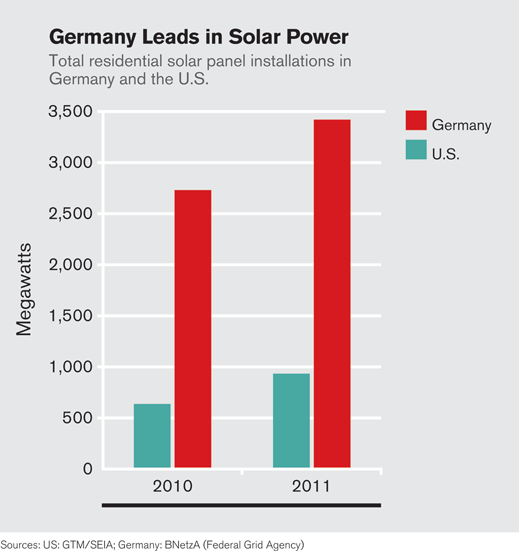Why Solar Installations Cost More in the U.S. than in Germany
In 2011, residential solar system installers paid a little over $1.80 per watt for solar panels in both Germany and the United States. In Germany, installers added $1.20 to the cost of the solar panel to complete an installation. But in the U.S., they tacked on $4.36 per watt, more than three times as much.
A report released this month by Lawrence Berkeley National Laboratory explains why.
The most obvious difference between the United States and Germany is the total amount of solar power installed in each country—there’s five times as much installed in Germany.
The study concludes, however, that the learning curve isn’t enough to explain the price disparity—it might account for only half of it. Instead, based on a survey of U.S. and German installers, it seems that there are some fundamental differences in the U.S. and German markets that could keep prices higher in the U.S.—unless something is done to address them.

The most marked difference is in the cost of acquiring customers. German installers spend seven cents per watt of installed capacity on things like marketing and designing systems for specific customers. U.S. installers spend 10 times that amount. Costs for permitting, connecting the systems to the grid, and having them inspected are also far higher in the United States. The Germans spent only three cents a watt on these things, while U.S. installers spend 20 cents, in part because of larger amounts of paperwork and the fact that U.S. installers have to pay permitting fees.
U.S. installers also spend more on labor during actual installation (in some cases, higher winds force more expensive installations). They pay more in sales tax (German installers are exempt). And they pay more for overhead (which is closely related to economies of scale).
The report lists some more line items. Part of the difference, for example, is due to higher costs for inverters in the U.S. But the report comes short of explaining the entire price difference—about $1.30 of the price difference remains unaccounted for. The researchers speculate that some part of that difference is coming from U.S. installers taking higher profits.
The U.S. Department of Energy’s SunShot Initiative is funding projects aimed at reducing the non-hardware costs of an installed solar system. One part of SunShot is a $12 million program is aimed at cutting red tape. Earlier this year it announced a $10 million prize to be given to companies that can lower total non-hardware costs of an installation to below $1 per watt. And this month it announced $21 million for the development of a “plug-and-play” system for solar panels that could reduce installation costs (see “Redesigning Solar Power”).

The biggest lever for reducing solar costs remains reducing the number of solar panels needed per installation, which in turn reduces labor costs (see “Alta Devices: Finding a Solar Solution”). But for solar to compete with fossil fuels, directly addressing the soft costs will be key. “We will see a substantial improvement, even if we just replicate the practices in Germany,” says Ryan Wiser, a staff scientist at LBNL and one of the authors of the new report.
Keep Reading
Most Popular
Large language models can do jaw-dropping things. But nobody knows exactly why.
And that's a problem. Figuring it out is one of the biggest scientific puzzles of our time and a crucial step towards controlling more powerful future models.
How scientists traced a mysterious covid case back to six toilets
When wastewater surveillance turns into a hunt for a single infected individual, the ethics get tricky.
The problem with plug-in hybrids? Their drivers.
Plug-in hybrids are often sold as a transition to EVs, but new data from Europe shows we’re still underestimating the emissions they produce.
Google DeepMind’s new generative model makes Super Mario–like games from scratch
Genie learns how to control games by watching hours and hours of video. It could help train next-gen robots too.
Stay connected
Get the latest updates from
MIT Technology Review
Discover special offers, top stories, upcoming events, and more.